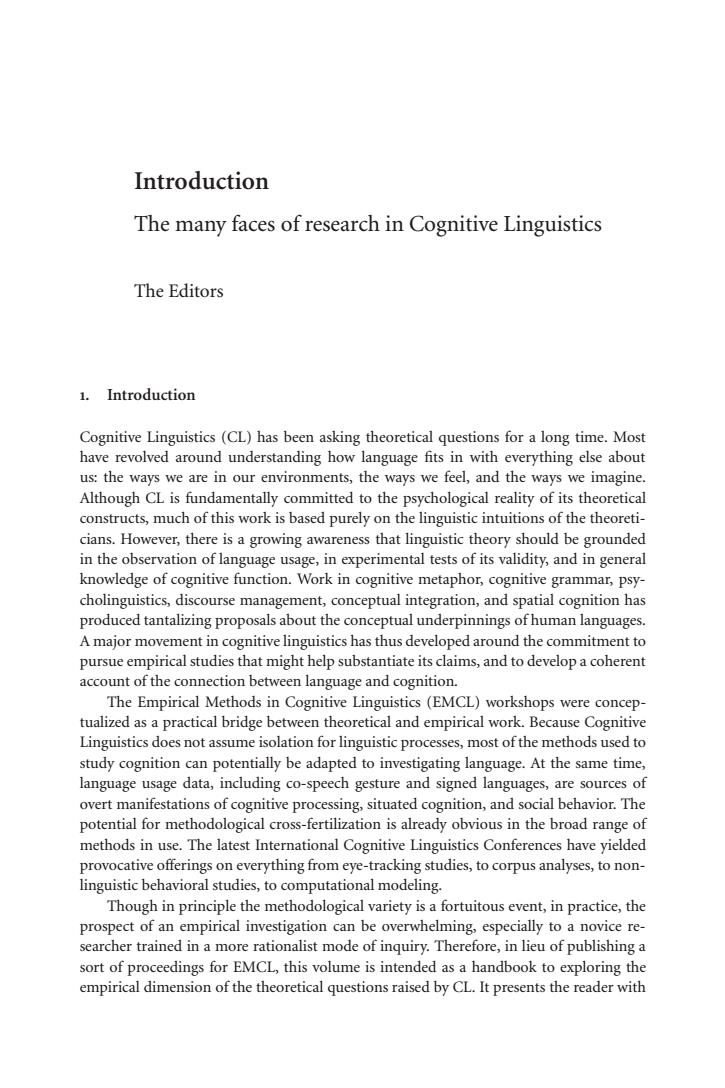正在加载图片...

Introduction The many faces of research in Cognitive Linguistics The Editors 1.Introduction Cognitive Linguistics (CL)has been asking theoretical questions for a long time.Most have revolved around understanding how language fits in with everything else about us:the ways we are in our environments,the ways we feel,and the ways we imagine. Although CL is fundamentally committed to the psychological reality of its theoretical constructs,much of this work is based purely on the linguistic intuitions of the theoreti- cians.However,there is a growing awareness that linguistic theory should be grounded in the observation of language usage,in experimental tests of its validity,and in general knowledge of cognitive function.Work in cognitive metaphor,cognitive grammar,psy- cholinguistics,discourse management,conceptual integration,and spatial cognition has produced tantalizing proposals about the conceptual underpinnings of human languages. A major movement in cognitive linguistics has thus developed around the commitment to pursue empirical studies that might help substantiate its claims,and to develop a coherent account of the connection between language and cognition. The Empirical Methods in Cognitive Linguistics(EMCL)workshops were concep- tualized as a practical bridge between theoretical and empirical work.Because Cognitive Linguistics does not assume isolation for linguistic processes,most of the methods used to study cognition can potentially be adapted to investigating language.At the same time, language usage data,including co-speech gesture and signed languages,are sources of overt manifestations of cognitive processing,situated cognition,and social behavior.The potential for methodological cross-fertilization is already obvious in the broad range of methods in use.The latest International Cognitive Linguistics Conferences have yielded provocative offerings on everything from eye-tracking studies,to corpus analyses,to non- linguistic behavioral studies,to computational modeling. Though in principle the methodological variety is a fortuitous event,in practice,the prospect of an empirical investigation can be overwhelming,especially to a novice re- searcher trained in a more rationalist mode of inquiry.Therefore,in lieu of publishing a sort of proceedings for EMCL,this volume is intended as a handbook to exploring the empirical dimension of the theoretical questions raised by CL.It presents the reader withJB[v.20020404] Prn:12/04/2007; 9:53 F: HCP18IN.tex / p.1 (46-122) Introduction The many faces of research in Cognitive Linguistics The Editors . Introduction Cognitive Linguistics (CL) has been asking theoretical questions for a long time. Most have revolved around understanding how language fits in with everything else about us: the ways we are in our environments, the ways we feel, and the ways we imagine. Although CL is fundamentally committed to the psychological reality of its theoretical constructs, much of this work is based purely on the linguistic intuitions of the theoreticians. However, there is a growing awareness that linguistic theory should be grounded in the observation of language usage, in experimental tests of its validity, and in general knowledge of cognitive function. Work in cognitive metaphor, cognitive grammar, psycholinguistics, discourse management, conceptual integration, and spatial cognition has produced tantalizing proposals about the conceptual underpinnings of human languages. A major movement in cognitive linguistics has thus developed around the commitment to pursue empirical studies that might help substantiate its claims, and to develop a coherent account of the connection between language and cognition. The Empirical Methods in Cognitive Linguistics (EMCL) workshops were conceptualized as a practical bridge between theoretical and empirical work. Because Cognitive Linguistics does not assume isolation for linguistic processes, most of the methods used to study cognition can potentially be adapted to investigating language. At the same time, language usage data, including co-speech gesture and signed languages, are sources of overt manifestations of cognitive processing, situated cognition, and social behavior. The potential for methodological cross-fertilization is already obvious in the broad range of methods in use. The latest International Cognitive Linguistics Conferences have yielded provocative offerings on everything from eye-tracking studies, to corpus analyses, to nonlinguistic behavioral studies, to computational modeling. Though in principle the methodological variety is a fortuitous event, in practice, the prospect of an empirical investigation can be overwhelming, especially to a novice researcher trained in a more rationalist mode of inquiry. Therefore, in lieu of publishing a sort of proceedings for EMCL, this volume is intended as a handbook to exploring the empirical dimension of the theoretical questions raised by CL. It presents the reader with